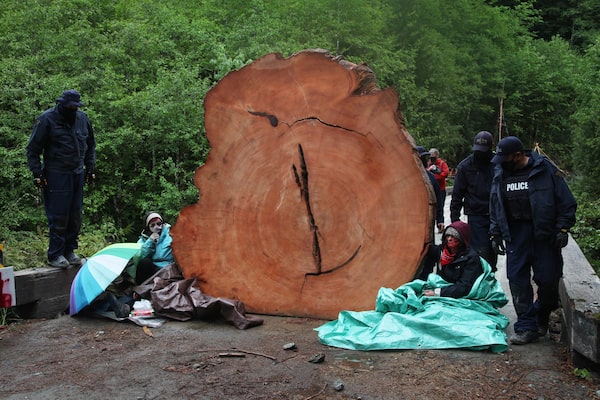It looks like last week’s newsletter was sent out yesterday afternoon by mistake. Sorry about that! Here is the new edition. Hope you had a lovely long weekend.
Good afternoon, and welcome to Globe Climate, a newsletter about climate change, environment and resources in Canada.
Last week we took a dive into prepping for gardening season.
This week: Have a look inside the showdown at Toronto Botanical Garden, which is pitting green thumbs against accountants. At this point, you may be thinking, so what? A minor power struggle at an obscure public garden? But the tiny tempest is raising big questions as spring rises and freedom beckons in the post-COVID city.
Also havens of green are spreading pandemic across the alleyways of Montreal.
Now, let’s catch you up on other news.
Noteworthy reporting this week:
- Plastics manufacturers are taking the federal government to court after Ottawa designated their products as toxic, arguing the move is not rooted in science and constitutes significant political overreach.
- Business commentary: What will Canada get for the $8-billion it’s about to spend on lowering emissions from large industry? Climate columnist Adam Radwanski digs in.
- Pipelines: We’ve got an explainer about what you need to know about Line 5, now at the centre of a U.S.-Canada legal dispute. Meanwhile, Woodside Petroleum Ltd. is seeking to exit from the struggling Kitimat LNG project in B.C. A British Columbia First Nations coalition says it’s disappointed by the news.
- Old-growth logging: Roughly 60 protesters have been arrested in a Vancouver Island logging blockade for defying a court injunction obtained by the logging company that has rights to the area. Tzeporah Berman was arrested at the blockade, after writing about why she continues to fight for B.C.’s old-growth forests.

RCMP assess how to remove two protesters chained to a tree stump at an anti-logging blockade in Caycuse, B.C., on Tuesday, May 18, 2021. Remote forest areas of southern Vancouver Island were the scene of more arrests Wednesday as police continue to enforce a British Columbia Supreme Court injunction against anti-logging protesters camped in the wilderness.Jen Osborne/The Canadian Press
A deeper dive
Behind the story of thwarted efforts to help steelhead trout
Justine Hunter is a Globe and Mail political reporter based in B.C. For this week’s deeper dive, she shares some details behind her story about how Ottawa thwarted efforts to help an endangered species
The population of steelhead trout in British Columbia’s southern interior have collapsed, and three years ago scientists were waging a behind-the-scenes battle over what it would take to save them from extinction.
Jesse Zeman, director of fish and wildlife restoration for the B.C. Wildlife Federation, caught word about a dispute. It was no secret that the steelhead, renowned by anglers around the globe for their strength and elusiveness, were in trouble. Their annual return to the Thompson and Chilcotin rivers had dwindled from thousands to a couple of hundred.
The Committee on the Status of Endangered Wildlife in Canada declared the population was at imminent risk of extinction in January, 2018, forcing the Department of Fisheries and Oceans (DFO) to respond with a scientific report. The findings were suspiciously mild. Instead of modifying the lucrative salmon fishery on the Fraser to allow the steelhead to safely return to spawn, the report permitted the status quo to continue.
Mr. Zeman submitted a request under the federal Access to Information and Privacy (ATIP) law to find out what happened. It took him more than two years to finally see some of the material he had asked for.
At one point, he was told the documents he was looking for would stack up to 5 metres high. Roughly 10 million pages generated on a short window in the history of DFO’s management of a single population of trout.
“The ATIP Secretariat will have to take a legal extension in order to process your request,” officials told him. “We can only take a guess at the amount of time that we would take for volume. There is generally a 30 day extension per 1,000 pages,” the ATIP analyst wrote.
That would be, he calculated, 822 years to complete the process.
Persistent as any angler, Mr. Zeman kept up the fight, and finally landed roughly 2,800 pages of documents that confirmed that DFO had edited the report in a way that was inconsistent with science.
-Justine
What else you missed
- Canada Energy Regulator gives okay to Hydro-Quebec transmission line
- Early results from a provincial survey on coal mining in the Rocky Mountains show Albertans have major concerns about expanding the industry. Meanwhile, one coal company asks court to quash an order for federal environmental review of proposed Alberta mine expansion
- Canada Energy Regulator says COVID-19 pandemic linked to 15 per cent drop in fossil fuel use in 2020
- The maritime shipping industry will fall short of achieving net zero greenhouse gas emissions by 2050, the International Energy Agency said in a report
- The costs of Alberta’s growing stock of abandoned and inactive oil and gas wells are falling unfairly on landowners and taxpayers, a University of Calgary report says
Opinion and analysis
From The Narwhal, Carly Phillips: The vicious relationship between wildfires and climate change desperately needs human intervention
Jeffrey Jones: Canada will need to overhaul its economy to achieve net zero carbon emissions. But cultural change might prove even harder
Adam Radwanski: Less talk, more action. Canada gets a reality check on its dreams of being an EV powerhouse
Eric Reguly: German Greens could form the next government and launch an impossibly ambitious decarbonization crusade
Editorial board: The Age of Oil is coming to an end. What does that mean for Canada?
Green Investing
Why are advisors and investors so split on ESG investing?
After taking courses and educating herself on responsible investing (RI), Carol Smith understands that companies with strong environmental, social and governance (ESG) principles can experience improved financial performance – as can their stocks. She’s an financial advisor with Desjardins Financial Security Independent Network in Mississauga.
However, research shows that a significant percentage of advisors are not yet focusing on RI or discussing it with their clients. And while more investors may be interested in holding ESG investments, that doesn’t mean they’re bringing the topic up with their advisors.
This article is the first in a series on the challenges and opportunities in environmental, social and governance investing, and the great divisions in the investment industry on the attitudes to, and acceptance of, this rising trend.
- Power play: Why Canadian utility stocks look like a smart bet on EVs and a new age of electrification
- Opinion: Greening portfolios is harder than you think
- News: No pain, no gain for big funds hunting the next Tesla
Join The Globe’s Jeffrey Jones and industry leaders as they provide actionable insights and guidance on how to start, assess and grow the right ESG program for long-term success. Wednesday May 26 @ 1:30pm ET
Making waves
Each week The Globe will profile a Canadian making a difference. This week we’re highlighting the work of Shaelyn Wabegijig, who is helping set sustainable development goals.

Shaelyn Wabegijig prays.Handout
My name is Shaelyn Wabegijig. I’m Algonquin, German and Irish, and I grew up in Rama First Nation. I’m a 24-year-old Trent University alumna, based in Nogojiwanong/Peterborough, the traditional territory of the Michi Saagiig First Nations.
I’m a coordinator for the Kawartha World Issues Centre. From March 2020 to March 2021, I worked to advance the Sustainable Development Goals in Peterborough and the Kawarthas. I’m also one of seven youth, backed by Ecojustice, who are challenging the Ontario government’s inadequate climate targets. We say these threaten Ontarians’ rights to life, liberty and security of the person and the lives of youth and future generations.
Doing this work, I find solace by grounding into my place in the world. I know what’s important to me, what I value and what I can change – so I focus on that and try to leave a positive impact. This led me to work with many inspiring people who also care deeply about our environment and our shared future and are working every day to ensure we have one.
- Shaelyn
Do you know an engaged individual? Someone who represents the real engines pursuing change in the country? Email us at GlobeClimate@globeandmail.com to tell us about them.
Photo of the week

"Little Island" levitates on 132 huge concrete tulips installed on pillars on the banks of New York City's Hudson River. The US$260-million new floating public park was inaugurated to the delight of the public, after more than one year of pandemic.ANGELA WEISS/AFP/Getty Images
Catch up on Globe Climate
- Don’t underestimate the power of the garden
- High stakes in the Line 5 energy dispute
- Canadian youth demand action over words ahead of COP26
- If Canada is going to meet its new greenhouse gas emissions goal, it is going to have to be tactical
We want to hear from you. Email us: GlobeClimate@globeandmail.com. Do you know someone who needs this newsletter? Send them to our Newsletters page.
 Sierra Bein
Sierra Bein